Electronic Warfare and Radar Systems Engineering Handbook |
|
|
CIRCULATORS AND DIPLEXERS
If port 1 is the input, then the signal will come out of port 2; in an ideal situation, no signal should come out of port 3 which is called the isolated port. The insertion loss of the circulator is the loss from 1 to 2, while the loss from 1 to 3 is referred to as isolation. A typical circulator will have a few tenths of a dB insertion loss from port 1 to 2 and 20 dB of isolation from port 1 to 3 for coaxial circulators (30 dB or more for waveguide circulators). When the input is port 2, the signal will come out of port 3 and port 1 is the isolated port. Similar discussions can be applied to port 3.
As shown in Figure 2, if one port of a circulator is loaded, it becomes an isolator, i.e. power will pass from ports one to two, but power reflected back from port two will go to the load at port three versus going back to port one.
As shown in Figure 3 this circulator is made into a diplexer by adding a high pass filter to port two. Frequencies from port one that are below 10 GHz will be reflected by port two. Frequencies above 10 GHz will pass through port two. At the 10 GHz crossover frequency of the diplexer, a 10 GHz signal will be passed to both ports two and three but will be half power at each port. Diplexers or triplexers (one input and three output bands), must be specifically designed for the application.
The Maximum Input Power to a Measurement Device - The ideal input to a measurement device is in the 0 to 10 dBm ( 1 to 10 mW) range. Check manufacturer's specification for specific maximum value.
Figure 6. Low/High Band Configuration Figure 7. Alternate Low/High Band Configuration
Table of Contents for Electronics Warfare and Radar Engineering Handbook Introduction | Abbreviations | Decibel | Duty Cycle | Doppler Shift | Radar Horizon / Line of Sight | Propagation Time / Resolution | Modulation | Transforms / Wavelets | Antenna Introduction / Basics | Polarization | Radiation Patterns | Frequency / Phase Effects of Antennas | Antenna Near Field | Radiation Hazards | Power Density | One-Way Radar Equation / RF Propagation | Two-Way Radar Equation (Monostatic) | Alternate Two-Way Radar Equation | Two-Way Radar Equation (Bistatic) | Jamming to Signal (J/S) Ratio - Constant Power [Saturated] Jamming | Support Jamming | Radar Cross Section (RCS) | Emission Control (EMCON) | RF Atmospheric Absorption / Ducting | Receiver Sensitivity / Noise | Receiver Types and Characteristics | General Radar Display Types | IFF - Identification - Friend or Foe | Receiver Tests | Signal Sorting Methods and Direction Finding | Voltage Standing Wave Ratio (VSWR) / Reflection Coefficient / Return Loss / Mismatch Loss | Microwave Coaxial Connectors | Power Dividers/Combiner and Directional Couplers | Attenuators / Filters / DC Blocks | Terminations / Dummy Loads | Circulators and Diplexers | Mixers and Frequency Discriminators | Detectors | Microwave Measurements | Microwave Waveguides and Coaxial Cable | Electro-Optics | Laser Safety | Mach Number and Airspeed vs. Altitude Mach Number | EMP/ Aircraft Dimensions | Data Busses | RS-232 Interface | RS-422 Balanced Voltage Interface | RS-485 Interface | IEEE-488 Interface Bus (HP-IB/GP-IB) | MIL-STD-1553 & 1773 Data Bus | This HTML version may be printed but not reproduced on websites.
|
|
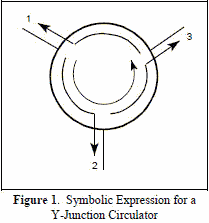 A microwave circulator is a nonreciprocal ferrite device which contains three or more ports. The input from
port n will come out at port n + 1 but not out at any other port. A three-port ferrite junction circulator, usually called the Y-junction circulator,
is most commonly used. They are available in either rectangular waveguide or strip- line form. The signal flow in the three-port circulator
is assumed as 1v2, 2v3, and 3v1 as shown in Figure 1.
A microwave circulator is a nonreciprocal ferrite device which contains three or more ports. The input from
port n will come out at port n + 1 but not out at any other port. A three-port ferrite junction circulator, usually called the Y-junction circulator,
is most commonly used. They are available in either rectangular waveguide or strip- line form. The signal flow in the three-port circulator
is assumed as 1v2, 2v3, and 3v1 as shown in Figure 1. 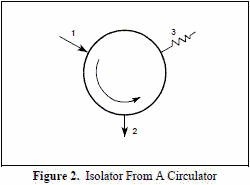
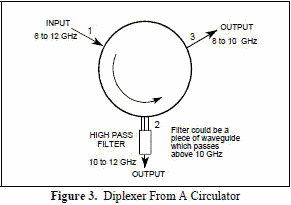
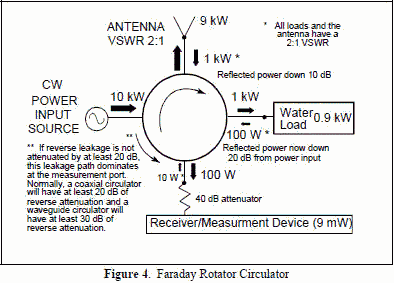 Another useful
device is the 4-port Faraday Rotator Circulator shown symbolically in Figure 4. These waveguide devices handle very high power and provide excellent
isolation properties. It is useful when measurements must be made during high power application as shown. A water load is used to absorb the
high power reflections so that a reasonable power level is reflected to the receiver or measurement port.
Another useful
device is the 4-port Faraday Rotator Circulator shown symbolically in Figure 4. These waveguide devices handle very high power and provide excellent
isolation properties. It is useful when measurements must be made during high power application as shown. A water load is used to absorb the
high power reflections so that a reasonable power level is reflected to the receiver or measurement port.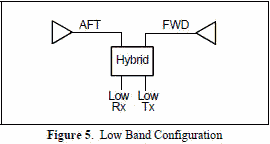 If the RF transmission lines and their components (antenna,
hybrid, etc.) can support the wider frequency range, circulators could be used to increase the number of interconnecting RF ports from two as
shown in Figure 5, to four as shown in Figure 6. Figure 7 shows an alternate configuration using diplexers which could actually be made from
circulators as shown previously in Figure 3.
If the RF transmission lines and their components (antenna,
hybrid, etc.) can support the wider frequency range, circulators could be used to increase the number of interconnecting RF ports from two as
shown in Figure 5, to four as shown in Figure 6. Figure 7 shows an alternate configuration using diplexers which could actually be made from
circulators as shown previously in Figure 3.